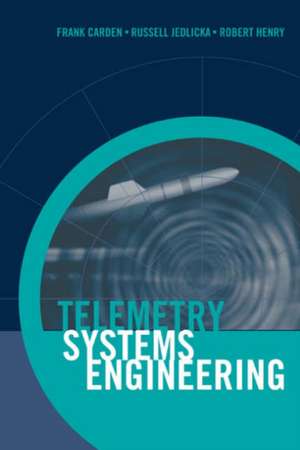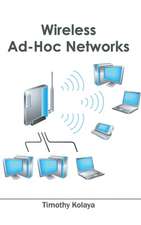Telemetry Systems Engineering: Artech House Telecommunications Library
Autor Frank Carden, Russ Jedlicka, Robert Henryen Limba Engleză Hardback – 31 dec 2001
Din seria Artech House Telecommunications Library
- 20%
 Preț: 512.30 lei
Preț: 512.30 lei - 20%
 Preț: 842.85 lei
Preț: 842.85 lei - 20%
 Preț: 757.91 lei
Preț: 757.91 lei - 20%
 Preț: 782.06 lei
Preț: 782.06 lei - 20%
 Preț: 684.11 lei
Preț: 684.11 lei - 20%
 Preț: 587.56 lei
Preț: 587.56 lei - 14%
 Preț: 793.62 lei
Preț: 793.62 lei - 20%
 Preț: 756.39 lei
Preț: 756.39 lei - 11%
 Preț: 515.87 lei
Preț: 515.87 lei - 11%
 Preț: 593.76 lei
Preț: 593.76 lei - 14%
 Preț: 903.02 lei
Preț: 903.02 lei - 14%
 Preț: 717.85 lei
Preț: 717.85 lei - 11%
 Preț: 602.01 lei
Preț: 602.01 lei - 14%
 Preț: 728.65 lei
Preț: 728.65 lei - 20%
 Preț: 759.00 lei
Preț: 759.00 lei - 14%
 Preț: 730.97 lei
Preț: 730.97 lei - 20%
 Preț: 861.89 lei
Preț: 861.89 lei - 20%
 Preț: 863.60 lei
Preț: 863.60 lei - 14%
 Preț: 726.01 lei
Preț: 726.01 lei - 11%
 Preț: 627.14 lei
Preț: 627.14 lei - 14%
 Preț: 844.61 lei
Preț: 844.61 lei - 11%
 Preț: 592.57 lei
Preț: 592.57 lei - 14%
 Preț: 846.39 lei
Preț: 846.39 lei - 20%
 Preț: 563.57 lei
Preț: 563.57 lei - 11%
 Preț: 629.35 lei
Preț: 629.35 lei -
 Preț: 239.25 lei
Preț: 239.25 lei -
 Preț: 260.37 lei
Preț: 260.37 lei - 20%
 Preț: 613.64 lei
Preț: 613.64 lei - 18%
 Preț: 547.10 lei
Preț: 547.10 lei - 18%
 Preț: 665.87 lei
Preț: 665.87 lei - 18%
 Preț: 542.48 lei
Preț: 542.48 lei - 20%
 Preț: 562.07 lei
Preț: 562.07 lei - 18%
 Preț: 543.61 lei
Preț: 543.61 lei - 20%
 Preț: 64.70 lei
Preț: 64.70 lei -
 Preț: 439.19 lei
Preț: 439.19 lei -
 Preț: 259.98 lei
Preț: 259.98 lei - 11%
 Preț: 617.76 lei
Preț: 617.76 lei - 11%
 Preț: 634.54 lei
Preț: 634.54 lei -
 Preț: 440.35 lei
Preț: 440.35 lei - 14%
 Preț: 892.11 lei
Preț: 892.11 lei - 20%
 Preț: 565.60 lei
Preț: 565.60 lei -
 Preț: 247.07 lei
Preț: 247.07 lei - 18%
 Preț: 640.56 lei
Preț: 640.56 lei - 15%
 Preț: 515.26 lei
Preț: 515.26 lei - 11%
 Preț: 576.29 lei
Preț: 576.29 lei - 11%
 Preț: 687.73 lei
Preț: 687.73 lei - 20%
 Preț: 594.57 lei
Preț: 594.57 lei - 18%
 Preț: 508.98 lei
Preț: 508.98 lei - 15%
 Preț: 686.73 lei
Preț: 686.73 lei
Preț: 996.27 lei
Preț vechi: 1094.80 lei
-9% Nou
Puncte Express: 1494
Preț estimativ în valută:
190.66€ • 198.32$ • 157.40£
190.66€ • 198.32$ • 157.40£
Carte disponibilă
Livrare economică 24 martie-07 aprilie
Livrare express 07-13 martie pentru 54.11 lei
Preluare comenzi: 021 569.72.76
Specificații
ISBN-13: 9781580532570
ISBN-10: 1580532578
Pagini: 596
Dimensiuni: 170 x 226 x 40 mm
Greutate: 1.13 kg
Ediția:2
Editura: Artech House Publishers
Seria Artech House Telecommunications Library
ISBN-10: 1580532578
Pagini: 596
Dimensiuni: 170 x 226 x 40 mm
Greutate: 1.13 kg
Ediția:2
Editura: Artech House Publishers
Seria Artech House Telecommunications Library
Cuprins
Telemetry System Definition -- Introduction, Learning Objectives, Telemetry System Overview. Data Collection System. Multiplex System. Modular, Transmitter and Antenna. Transmission or Waveform Channel. Antenna, RF Receiver: RF and IF Amplifiers Carrier. Demultiplex System. Data Processing and Display. IRIG Channel Standards. Analog Frequency Modulation -- Introduction. Learning Objectives Single Channel FM. FM/FM IRIG Spectrum Utilization. FM/FM Systems Contaminated with Noise. FM/FM Multiplex Systems. Operational Filter Bandwidths. Development of the FM Noise Model and Signal-to-Noise Ratio. Effect of Increasing the IF Bandwidth. Design of FM/FM Systems -- Introduction. Learning Objectives. System Parameters. Design Procedure. Design Examples. Threshold IF Bandwidth Utilization. Hardware Implementation of the Preemphasis Schedule. IRIG BIF Specifications. Pulse Code Modulation -- Learning Objectives. Overview. Digital Signal Representation. Baud and Bit Rate. Quantization and Analog-to-Digital Conversion. TM Channel Formats -- Learning Objectives. Line Coding or Transmission Format. Frame Construction. IRIG Specifications. PCM/FM (Binary FSK) -- Introduction. Learning Objectives. PCM/FM Waveform. PCM/FM System Design. Signal-to-Noise Ratio in a PCM/FM System. PCM/FM + FM/FM System Design. PCM/FM/FM. Signal-to-Noise Ratio for PCM Including Both. Quantization and Bit Error Noise. Power/Noise Concepts of BPSK Modulation -- Introduction. Learning Objectives. Expanded BPSK. BPSK Generation. BPSK Detection by a Correlation Receiver. Maximum Likelihood Detection. Bit Errors. BASK Modulation. BASK in General. Actual Receiving Hardware. Comparison of Bit Error Rates for BASK and PCB/FM. Q-Function. BASK Power Spectral Density. Overall Comparison Between PCB/FM and BASK. General PM Modulation Comparison of PM and FM Modulation. FM Modulation Employing a PM Modulator. Differential Phase Shift Keying. QPSK, (new) -- Introduction. Learning Objectives. DEQPSK. DQPSK. OKQPSK. MSK. Feher’s QPSK. Enhanced FQPSK, QPSK Schemes Designed to Replace Feher’s. Problems. Bandwidth Efficient Modulation Techniques (new) -- Learning Objectives. Introduction to M-ary, Signal Constellations. M-ASK. M-ASK. M-FSK. M-PSK. Combined Amplitude and Phase Modulation. QAM.


















